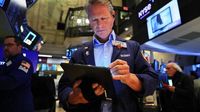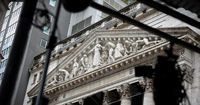U.S. stock markets experienced a significant rebound on Tuesday, April 8, 2025, following a tumultuous period marked by steep sell-offs driven by President Donald Trump’s controversial tariff policies. After three days of heavy losses, the Dow Jones Industrial Average surged over 1,200 points, or more than 3%, while the S&P 500 and Nasdaq both climbed by more than 3% as well. This recovery brought momentary relief to investors who had seen trillions of dollars wiped from equity markets over the previous week.
The market's upswing was partly fueled by positive movements in overseas markets. Japan's Nikkei stock index surged nearly 6% after the White House indicated it was opening bilateral trade negotiations with Japan, one of its key allies. Similarly, European markets also posted gains, buoyed by a stronger outlook for defense groups and a notable increase in Medicare payments announced by the Centers for Medicare & Medicaid Services, which saw a 5.06% rise for next year.
Despite the brief rally, analysts cautioned that the market remains skittish. Steve Sosnick, chief strategist at Interactive Brokers, noted, "Markets remain relatively thin and skittish. So each of these moves get amplified, that’s what we're seeing today: a little bit of bargain hunting, which does make sense, but then we're also seeing a little bit of a feeding frenzy that gets amplified." This sentiment reflects the uncertainty that continues to loom over the market as investors grapple with the implications of Trump's tariffs.
On Monday, April 7, the S&P 500 had fallen by 0.23%, marking a third consecutive day of losses, while the Dow Jones dropped by 0.91%. The Nasdaq Composite, however, saw a slight increase of 0.099% amidst the chaos. The volatility was further exacerbated by unfounded reports circulating on social media that Trump was considering a 90-day pause on the tariffs, which briefly caused the S&P to spike over 7% before quickly reversing as the White House dismissed the claims as "fake news."
In a stark escalation of trade tensions, Trump announced on social media that he would impose an additional 50% tariff on Chinese goods starting Thursday, April 10, 2025, unless China rescinded its planned 34% retaliatory duty on U.S. imports. Trump stated, "Additionally, all talks with China concerning their requested meetings with us will be terminated!" This declaration prompted a swift response from China’s Ministry of Commerce, which described the tariff threats as a "mistake on top of a mistake," asserting that China would "fight it to the end" if the U.S. persisted in its aggressive stance.
The uncertainty surrounding the tariffs has also impacted business sentiment domestically. The National Federation of Independent Business reported that its small business optimism index saw its largest one-month decline since December 2020, reflecting heightened uncertainty among small business owners regarding the future.
As the market opened on Tuesday, futures tied to the S&P 500 and Nasdaq indicated a potential recovery, with increases of 0.98% and 1.02%, respectively. Investors were looking for signs of a turnaround, and the positive performance in Asian markets provided a glimmer of hope. The Hang Seng Index in Hong Kong rose more than 2.3%, recovering from a significant plunge earlier in the week, while South Korea's Kospi and Australia's ASX 200 both gained approximately 1.5%.
Despite this bounce-back, market analysts are cautious about interpreting these gains as a sign of stability. Goldman Sachs analysts warned against reading too much into short-term rebounds, stating, "Bear market rallies are quite common," and citing historical patterns of market recovery following significant downturns.
Trump's tariffs have raised concerns about a potential global trade war, with analysts suggesting that the prospect of tariffs reaching up to 104% on Chinese goods could lead to severe economic repercussions. Treasury Secretary Scott Bessent characterized China's response as a "big mistake" and criticized the nation's aggressive posture. He emphasized that while some favorable trade agreements could be reached with individual countries, the overarching tariff strategy may remain intact.
As the corporate earnings season approaches, with major reports expected from Delta Airlines and large U.S. banks, the impact of tariffs on earnings will be a critical focal point for investors. Sosnick remarked, "People are confused, scared, and angry," reflecting the prevailing sentiment among market participants as they navigate the complexities of the current economic landscape.
In the midst of these developments, the price of gold has surged, exceeding $3,000 an ounce, as investors seek safe-haven assets amid the uncertainty. Financial analysts have drawn parallels between the current economic climate and the geopolitical tensions of the late 1970s and 1980s, when gold prices also spiked significantly.
Despite the temporary relief seen in the markets, the uncertainty surrounding Trump's tariff policies continues to loom large. Investors remain vigilant, weighing the potential for further escalations in trade tensions against the backdrop of an unpredictable political landscape. With each new announcement from the White House, the markets are left to react, often with dramatic swings that reflect the underlying anxiety permeating the financial sector.
As the situation develops, both domestic and international markets will be closely monitored for signs of stabilization or further volatility. The next few days will be crucial as investors digest the implications of Trump's tariff announcements and their potential impact on global trade dynamics.







